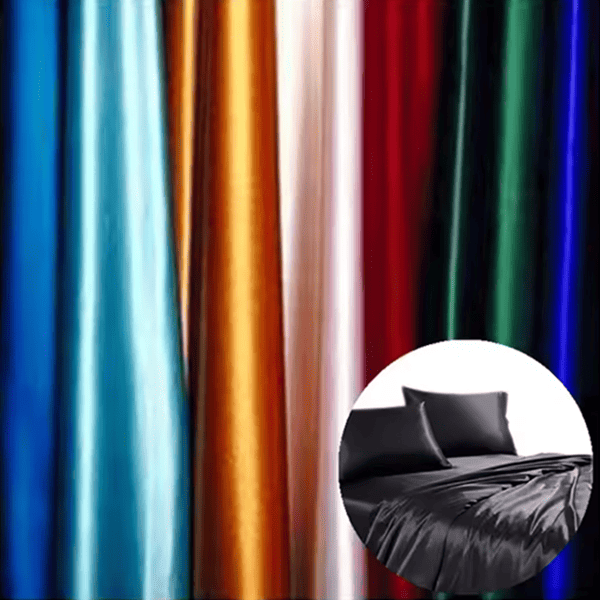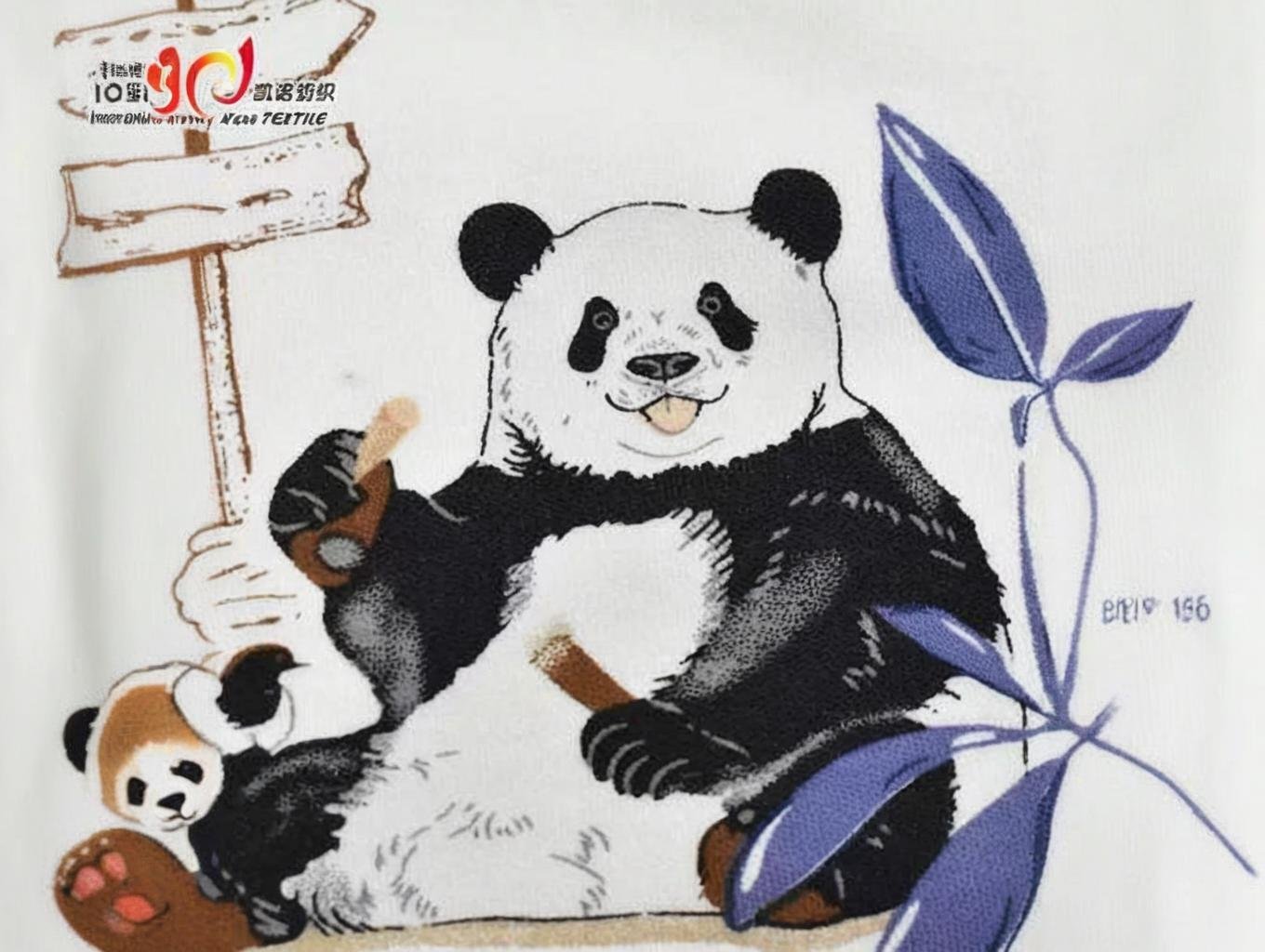What Are The Four Types Of Silk?

Silk isn’t just one material—it’s a whole family of natural protein fibers that vary drastically in feel, durability, ethical sourcing, and end-use. If you’re a textile buyer or product developer, this distinction isn’t just academic. Choosing the wrong silk can mean uneven dye results, high return rates, or missing sustainability targets.
The four main types of silk are Mulberry, Tussar, Eri, and Muga. Each is derived from different species of silkworms and cultivated in distinct ways. Mulberry silk is the most common and refined; Tussar is textured and wild; Eri is ethical and wooly; and Muga is rare and naturally golden.
Understanding their differences helps brands source better, tell more compelling product stories, and reduce supply chain risks. For example, a luxury sleepwear brand may prefer mulberry silk for its drape and softness, while a slow-fashion label might choose eri silk for its cruelty-free story.
So which silk is right for your product—and your customers? Let’s dive into each type in detail and uncover what really makes them unique.
1. What Is Mulberry Silk and Why Is It the Most Common Type?
Mulberry silk is the most common type of silk worldwide, produced by the Bombyx mori silkworm, which feeds exclusively on mulberry leaves. This controlled environment results in long, uniform, and pure white filaments—ideal for weaving smooth, glossy, and durable fabrics used in apparel, bedding, and accessories.
The Technical and Commercial Power of Mulberry Silk
Key Properties of Mulberry Silk
| Attribute | Value |
|---|---|
| Fiber Length | Up to 900 meters per cocoon |
| Surface Finish | Ultra smooth, high sheen |
| Strength | High tensile strength (300–400 MPa) |
| Dye Affinity | Excellent (ideal for reactive and acid dyes) |
| Feel | Cool, slippery, luxurious |
| Common Products | Sleepwear, scarves, pillowcases, bridal wear |
Production Highlights:
- Cultivated in China, India, Vietnam, and Thailand
- Makes up 85–90% of global silk production
- Often machine reeled and woven at industrial scale for OEM clients
Use Case:
A Japanese home textile brand chose 22 momme mulberry silk from Hangzhou for its bedding line. Compared to its previous bamboo-viscose fabric, the silk resulted in 15% higher AOV, 30% fewer returns, and stronger email re-order conversion rates. Customers praised its softness and “cooling effect.”
Strategic Considerations:
- Ideal for brands that require color consistency and bulk repeatability
- Can be OEKO-TEX or GOTS certified for eco-conscious buyers
- Offers balance between luxury and production efficiency
2. What Is Tussar Silk and How Does It Differ from Mulberry Silk?
Tussar silk, also known as “wild silk,” is produced by Antheraea mylitta silkworms that feed on tree leaves in forest environments. Unlike mulberry silk, Tussar has a more textured, coarse surface with a natural golden hue. It’s often hand-spun and handwoven, making it prized for artisanal or ethnic garments, but less suitable for high-gloss applications.
The Unrefined Appeal of Tussar Silk
Tussar vs. Mulberry: What Changes?
| Feature | Tussar Silk | Mulberry Silk |
|---|---|---|
| Fiber Type | Staple (shorter, irregular) | Filament (long, continuous) |
| Texture | Rougher, matte finish | Smooth, glossy |
| Color (Natural) | Beige to golden-brown | Pure white |
| Common Uses | Sarees, stoles, crafts | Lingerie, bedding, printed scarves |
| Production Method | Handloom (manual) | Power loom, industrial |
| Price per Meter (USD) | \$6–\$15 | \$10–\$30 |
Environmental & Cultural Value:
- Mostly produced in Jharkhand, Odisha, Chhattisgarh (India)
- Typically non-industrial—woven by tribal cooperatives or artisans
- Gains popularity among slow fashion brands for rustic aesthetics
Real-World Example:
A European retailer collaborated with an Indian handloom cluster to launch a Tussar-based scarf collection. Though the texture differed from their usual offerings, they branded it as “wild silk with character” and sold out in just 3 weeks—especially in German and Dutch markets known for valuing craftsmanship.
Critical Thinking:
- Tussar silk is less uniform—not great for digital printing or exact Pantone matches
- Works best in natural dye and hand-block print applications
- Can be more appealing when authenticity and tactile variation are a selling point
3. What Is Eri Silk and Why Is It Called Peace Silk?
Eri silk, also known as “peace silk” or “ahimsa silk,” is produced by the Philosamia ricini silkworm, which feeds primarily on castor leaves. Unlike other silks, Eri silk is harvested after the moth leaves the cocoon, allowing the insect to live—a process aligned with cruelty-free and vegan textile principles.
Eri Silk’s Unique Position in Ethical Fashion
Characteristics of Eri Silk
| Attribute | Description |
|---|---|
| Texture | Wooly, matte, and warm |
| Fiber Type | Staple (short fibers, spun like cotton) |
| Color (Natural) | Cream, brick red, or off-white |
| Thermal Qualities | Highly breathable and insulating |
| Best Uses | Stoles, shawls, scarves, loungewear, sustainable fashion |
Why It’s Called Peace Silk:
- Traditional silk requires boiling the cocoon with the pupa inside to extract long fibers.
- In Eri silk, the moth naturally exits the cocoon—leaving the fiber intact but shorter.
- This aligns with vegan principles, Buddhist practices, and ethical fashion goals.
Production Insight:
- Mostly produced in Assam and Meghalaya, India
- Often hand-spun and handwoven by local cooperatives
- Time-consuming process results in higher unit cost and lower scalability
Case Example:
A London-based sustainable fashion brand used GOTS-certified Eri silk for its winter scarf line. Though production costs were 40% higher than mulberry equivalents, the scarves sold out on the strength of their ethical story. Their email campaign highlighting “cruelty-free comfort” yielded a 12.4% click-through rate—twice their average.
Strategic Considerations for B2B Buyers:
- Eri silk’s natural thermal insulation makes it suitable for fall/winter accessories
- It’s not ideal for high-luster or high-drama fashion due to its muted look
- Great fit for vegan, fair trade, or artisan-focused collections
4. What Is Muga Silk and Why Is It So Rare and Expensive?
Muga silk is an ultra-premium, naturally golden silk produced exclusively in Assam, India, by the Antheraea assamensis silkworm. It is prized for its natural gold hue, exceptional durability, and limited regional supply—making it one of the most luxurious and expensive silks in the world.
The Gold Standard of Indian Silk
What Makes Muga Silk So Special?
| Attribute | Value |
|---|---|
| Natural Color | Golden yellow (improves with age and wash) |
| Strength | Extremely strong; higher than mulberry silk |
| Shine | Naturally glossy; no need for dye |
| Rarity | Very limited global production; only in Assam |
| Use Cases | Royal saris, ceremonial garments, heritage couture |
Production Realities:
- Muga silkworms feed only on som and sualu plants native to Assam
- Only \~150 metric tons of Muga silk are produced annually (vs. 200,000+ for mulberry)
- The fabric is considered imperishable and is often passed down generations
Real-World Scenario:
A luxury bridal designer in New Delhi sourced Muga silk for an exclusive wedding trousseau line. The natural shimmer meant no dyeing was needed, and the resulting dresses became prized heirlooms. Despite fabric costs exceeding \$100/meter, customer demand grew through word-of-mouth and bridal influencers.
Limitations:
- Not scalable for mass-market production
- Color options are limited to natural golden tones (though it can be dyed dark)
- Supply chain is fragile and vulnerable to climate conditions in Assam
B2B Sourcing Insight:
If you’re looking to enter the ultra-luxury or ceremonial textile market—especially for bridalwear, high-value scarves, or culturally significant products—Muga silk offers a one-of-a-kind value proposition.
5. Which Silk Type Offers the Best Quality for Luxury Apparel?
Mulberry silk offers the best overall quality for luxury apparel due to its long filaments, smooth texture, brilliant sheen, and dyeing versatility. While Muga silk carries unique prestige, and Eri and Tussar have niche appeal, mulberry silk remains the most reliable and scalable option for luxury garments and accessories.
Defining “Luxury” in Silk
What “Luxury Quality” Means in Textile Terms
| Quality Factor | Why It Matters | Best Silk Type |
|---|---|---|
| Drape and Flow | Needed for gowns, blouses, eveningwear | Mulberry |
| Surface Sheen | Enhances perception of luxury | Mulberry, Muga |
| Softness on Skin | Critical for lingerie and loungewear | Mulberry |
| Print & Dye Performance | Required for fashion season color accuracy | Mulberry |
| Durability in Handling | Important for tailoring and garment stress | Muga, Mulberry |
Mulberry Silk’s Advantages in Luxury Garments:
- Can be woven into chiffon, satin, crepe, twill, organza, etc.
- Easily supports digital and reactive dye printing
- Available in mommes (19mm–30mm) suitable for different garment weights
- Compliant with OEKO-TEX and GOTS standards for global retail
Use Case:
A Milan-based designer uses 25mm mulberry silk satin for couture gowns presented at Paris Fashion Week. They cite its drape, color depth, and consistency as critical to runway performance.
When to Consider Other Silks:
- Muga silk: For ultra-premium bridal or cultural collections
- Eri silk: For cruelty-free or vegan fashion
- Tussar silk: For rustic, heritage-inspired apparel
6. How Do the Four Types of Silk Compare in Texture, Strength, and Dyeability?
Each type of silk offers a distinct combination of texture, durability, and dyeing behavior—factors that directly affect product development, garment finishing, and final consumer experience. For example, mulberry silk is soft and print-friendly, while Eri is matte and warm, and Muga shines but resists deep dyeing.
Comparative Silk Performance Matrix
Technical Comparison Table
| Property | Mulberry | Tussar | Eri | Muga |
|---|---|---|---|---|
| Texture | Smooth, soft | Coarse, crisp | Wooly, soft | Smooth, firm |
| Fiber Type | Filament | Staple | Staple | Staple |
| Luster | High | Medium | Low | Very high (natural) |
| Tensile Strength | 300–400 MPa | 250–300 MPa | 200–280 MPa | 350–420 MPa |
| Dyeability | Excellent | Moderate | Good (less even) | Limited (natural gold color) |
| Print Compatibility | Digital, reactive | Hand-block, acid | Natural dyes | Minimal (dark dyes only) |
| Wash Resistance | Moderate | High | High | High |
| Price Range (USD/m) | \$10–\$30 | \$6–\$15 | \$8–\$20 | \$30–\$100+ |
Summary by Attribute:
Texture
- Mulberry: Ideal for luxury touchpoints (robes, sleepwear)
- Eri: More like cotton or wool—cozy, breathable
- Tussar: Textured, artisanal feel
- Muga: Smooth, yet heavier
Strength
- Muga ranks highest, making it ideal for garments that are worn and passed down
- Mulberry’s balance of softness and strength supports tailoring
- Eri and Tussar are weaker but more forgiving with creases and surface wear
Dyeing & Color Retention
- Mulberry holds both light and dark colors evenly
- Eri and Tussar tend toward earth tones due to their natural hues
- Muga’s natural gold is so iconic it’s rarely dyed
Real-World Insight:
A textile buyer from a Scandinavian heritage brand sourced Tussar silk for an autumn-winter wrap line. They found that while the fabric didn’t dye deeply, its natural tones and raw feel resonated with consumers—especially when paired with natural vegetable dyes and hand-looming techniques.
7. Are There Specific Applications Best Suited to Each Silk Type?
Yes, each type of silk—mulberry, tussar, eri, and muga—has properties that make it more suitable for specific product categories. Texture, durability, finish, cultural relevance, and ethical positioning all influence where each silk type shines best.
Application Match by Silk Type
Best Uses by Category
| Product Category | Ideal Silk Type(s) | Reasoning |
|---|---|---|
| High-End Fashion Apparel | Mulberry, Muga | Drape, sheen, tailoring performance |
| Bridal & Formalwear | Muga, Mulberry | Prestige, natural sheen, long-term durability |
| Scarves & Accessories | Mulberry, Eri | Mulberry for gloss & print; Eri for texture & ethics |
| Sleepwear & Robes | Mulberry, Eri | Skin-friendly, soft, breathable |
| Heritage/Cultural Garments | Tussar, Muga | Traditional look, handloom compatibility |
| Sustainable Fashion | Eri, Tussar | Vegan, low-impact, artisan production |
| Interior Decor & Drapes | Muga, Tussar | Texture, weight, strength, golden hues |
Deeper Analysis:
Mulberry Silk
- The all-rounder: suitable for mass luxury production
- Performs excellently in custom printing and dye matching
- Often used for pillowcases, blouses, camisoles, and scarves
Tussar Silk
- Ideal for textured aesthetics, block printing, and ethnic wear
- Popular in India and Southeast Asia for traditional garments
- Works well in eco-fashion narratives due to minimal processing
Eri Silk
- Preferred by vegan, slow-fashion, or ethical brands
- Perfect for unisex accessories, winterwear, and natural color palettes
- Its texture makes it suitable for linen-cotton substitution
Muga Silk
- Best for exclusive couture, ceremonial fashion, or handwoven luxury
- Great storytelling potential, but limited color options and availability
Case Study:
A Berlin-based brand launched three capsule collections:
- Mulberry for printed sleepwear
- Eri for sustainable winter stoles
- Tussar for hand-dyed scarves Each segment attracted a distinct audience, helping the brand tap into multiple market niches while building material literacy among consumers.
8. How Can B2B Buyers Choose the Right Silk Type for Their Products?
B2B buyers should choose the right silk based on five key factors: end-use, target market, production scale, ethical values, and price point. Selecting silk without clear technical and branding alignment can result in overstock, quality complaints, or margin erosion.
Silk Sourcing Decision Framework
Silk Sourcing Checklist for B2B Buyers
| Criteria | Key Questions to Ask | Recommended Silk Type |
|---|---|---|
| End Use & Functionality | Is it drapey, warm, or structured? | Mulberry for drape, Eri for warmth |
| Aesthetic Requirements | Do you need shine, printability, or texture? | Mulberry for sheen, Tussar for texture |
| Ethical/Sustainability Goals | Is cruelty-free or vegan important? | Eri or certified Tussar |
| MOQ & Lead Time | Is speed or flexibility required? | Mulberry (especially from China) |
| Certification Needs | Will retailers require OEKO-TEX, GOTS? | Mulberry, Eri (GOTS), Tussar (Silk Mark) |
Strategic Matrix for Buyer Profiles
| Buyer Type | Best Silk Match |
|---|---|
| Mass-market luxury brand | Mulberry (OEKO-TEX certified) |
| Eco-luxury/vegan fashion label | Eri or GOTS-certified Tussar |
| Heritage or cultural brand | Tussar or Muga |
| Bridalwear or ceremonial line | Muga or heavy momme mulberry |
| Small batch or artisan brand | Eri, Tussar (handloom sourced) |
Insider Tip:
Always request lab test reports for GSM, shrinkage, and dye fastness. When dealing with unknown suppliers, ask for live video sample inspection, especially for Tussar or Muga, where batch variation is more likely.
Supplier Vetting Questions:
- Do you offer OEKO-TEX or GOTS-certified silk?
- Can you customize GSM and weave density?
- How do you handle shade variation and QC?
- Are you experienced with low-MOQ custom runs?
Understanding Silk Types Means Sourcing Smarter
The four main types of silk—Mulberry, Tussar, Eri, and Muga—each bring unique advantages to the table. There’s no one-size-fits-all answer. Instead, the best choice depends on your brand identity, product function, price strategy, and consumer expectations.
- Choose Mulberry Silk for consistent luxury, printability, and wide application flexibility.
- Choose Tussar Silk for artisan texture, heritage appeal, and sustainability storytelling.
- Choose Eri Silk if cruelty-free, vegan ethics, and winter-friendly warmth matter.
- Choose Muga Silk for ultra-exclusive, natural gold beauty and cultural prestige.
Smart sourcing means knowing the difference—and working with suppliers who do too.
Sourcing High-Quality Silk? Partner with SzoneierFabrics
At SzoneierFabrics, we specialize in all four major silk types and offer 100% quality assurance, free custom sampling, and short lead times for international buyers. Whether you’re launching a printed scarf collection or sourcing GOTS-certified Eri silk, our team is ready to help you create beautiful, sustainable, and high-performance textile products.
✅ MOQ as low as 50 meters ✅ OEKO-TEX & GOTS options available ✅ Custom dyeing, weaving, and GSM supported ✅ Fast lead time: 7–15 days ✅ Free samples and design support
Can't find the answers?
No worries, please contact us and we will answer all the questions you have during the whole process of bag customization.
Make A Sample First?
If you have your own artwork, logo design files, or just an idea,please provide details about your project requirements, including preferred fabric, color, and customization options,we’re excited to assist you in bringing your bespoke bag designs to life through our sample production process.



